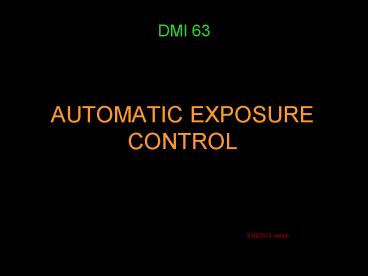AUTOMATIC EXPOSURE CONTROL PowerPoint PPT Presentation
1 / 22
Title: AUTOMATIC EXPOSURE CONTROL
1
AUTOMATIC EXPOSURE CONTROL
- DMI 63
3/10/2012 online
2
What Is Automatic Exposure Control? (AEC)
- Any device that measures quantity of radiation
either passing through Pt or image receptor
-then - Automatically terminates exposure when
predetermined optimal density is reached - You give up control of exposure density to a
machine! - Most technologists refer to AEC as phototiming
3
Purpose of AEC
- To deliver consistent, reproducible exposures
across a wide range of - Anatomical thicknesses
- Types of body parts and pts.
- Equipment
- Techs
- Rooms
4
DIFFERENT TYPES OF AEC
- 1. Phototiming (no computer involved)
- 2. Programmed Exposure (computer controlled)
- 3. Anatomically Programmed Radiography (APR)
(similar to Programmed Exposure but with little
pictures of anatomy) - All three of 3 types of AEC units use some type
of radiation detector device - Photodiodes (photocell)
- Ionization chamber
- And a backup timer
5
1. Phototiming System
- Earliest still widely used
- Uses photodiode detector
- Note Photodiode is after image receptor
6
Technique Selection is mostly done by Tech
mA kVp -based on body part thickness Level of
density (N, 1/2, 1 1/4 etc) (each increment
changes by approx. 30 per step) Backup time-
generally, 2 second or 1.5 times expected
exposure should be used in case AEC
fails Machine selects time!
7
2. Programmed Exposure System
- Uses microprocessor (computer)
- Microprocessor allows tech to digitally select
any kVp or mAs - then microprocessor automatically chooses mA
station and time - Backup times automatically programmed in
8
3. Anatomically Programmed Radiography
System(APR)
- Similar to Programmed Exposure System
- But uses touch screen with picture of anatomic
part instead of words or numbers - (essentially a computerized technique chart)
9
Radiation Detecting Devices
10
How a photodiode System works
- Radiation goes through Pt and image receptor
- To photo diode detector
- Diode lights up when hit by radiation
- Converts light to electric signal
- Exposure cuts off when signal reaches a
predetermined intensity
photcell
Photodiode detector
11
Ionization Chamber System
Most common type! Chamber is between pt and
image receptor (as opposed to photodiode system
which is after IR) Radiolucent so doesnt show
up on image
12
How Ionization Chambers Work
- Chambers contain cells filled with air
- During radiation exposure, air is ionized
- When charge reaches preset level in cell,
exposure terminates - Location of chambers shown by small rectangles on
image receptor
13
Compare Position of IR
Ionization Chamber
Phototiming
14
Proper Cell Selection
- Generally 2 or 3 cells
- Tech must select cells appropriate to area of
anatomical interest - Using 2 cells or even 3 creates a signal that is
averaged from for more uniform density
Image receptor
15
What cells would you select for-
- PA Chest ?
- Lateral Chest?
- Pelvis?
- Pelvis with Left prothesis?
- AP Lumbar spine?
Image receptor detector positions
16
AEC is used in Mammography
17
AEC does not relieve tech of following
obligations
- Skill in positioning!!!!
- Technique selection still need to select mA and
kVp and backup time (newer models build it in) - Anatomic recognition different parts require
different settings - Awareness of Idiosyncrasies of equipment
18
- Positioning accuracy is critical!
- Anatomy must be placed directly over correct
detector - Certain anatomy works well (abdomen)
- Certain anatomy does not (shoulder)
- Why might it not work well on children?
19
Important to remember!
- Never put contrast filled anatomy over AEC cell!
- Or breast implant
- Or metal prosthesis
- Or shielding
- All rooms arent calibrated the same
- Rooms change over time
- Service engineer calibrates initially using
phantom then must periodically recheck
20
Upside of using AEC
- Takes less time to set up technique -speeds up
exam - Improves exposure accuracy, as long as proper
positioning is used - Lowers repeat rate
- Saves pt exposure
- More consistency in density
- from visit to visit
- tech to tech
- room to room
- hospital to hospital
21
Downside of using AEC!
- Technologists come to depend upon system and when
it crashes, cant remember manual techniques! - Over-confidence in system may cause technologist
to become neglectful and commit errors - If you are not centered directly over area of
interest, exposure may not be correct - Cant use on portables or in OR
- AEC from room to room can be out- of -sync
- Could wind up doing many repeats!
22
Has Digital Radiography made AEC Obsolete?
- No!
- While digital equipment will override image
density produced by AEC, - AEC controls pt exposure- good for pt!
- whereas digital radiography only controls
appearance of image- pt. dosage doesnt matter
(techs will use too high techniques
intentionally!) - Should be used together!

